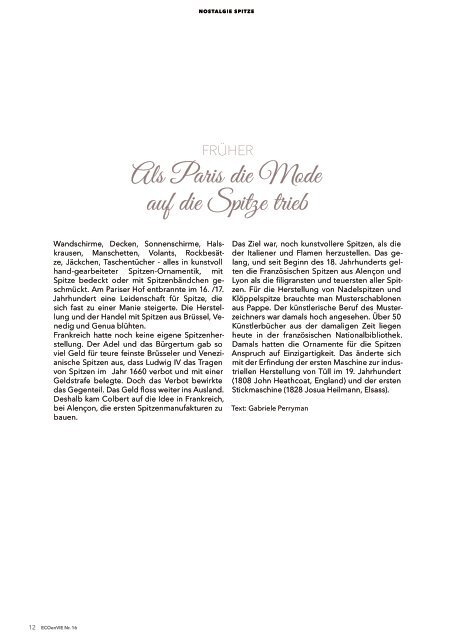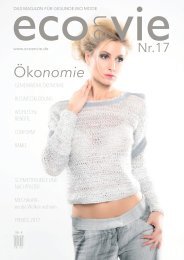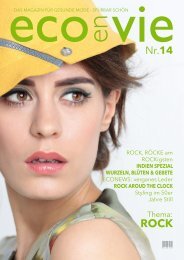ECOenVIE Nr. 16
Why did we decide for Lee as cover model in that outfit? For us she symbolizes the bridge to the African continent and thus to a subject that is concer- ning us all: People who give up their home and who have to find their way to our countries. Ho- ping for a better future for themselves and their children. Lee is wearing organic tulle, a fabric novelty made of organic cotton! Organic fashi- on urgently needs „bold“ fabrics and effect ma- terials for designers, the haute couture fashion, thus attracting attention and reaching the public because eco fashion is the future! The transparency of the net lace stands for the second aspect: transparency in the production, in dealing with people and especially in politics. More in the Magazin...
Why did we decide for Lee as cover model in that outfit?
For us she symbolizes the bridge to the African continent and thus to a subject that is concer- ning us all: People who give up their home and who have to find their way to our countries. Ho- ping for a better future for themselves and their children. Lee is wearing organic tulle, a fabric novelty made of organic cotton! Organic fashi- on urgently needs „bold“ fabrics and effect ma- terials for designers, the haute couture fashion, thus attracting attention and reaching the public because eco fashion is the future!
The transparency of the net lace stands for the second aspect: transparency in the production, in dealing with people and especially in politics.
More in the Magazin...
Sie wollen auch ein ePaper? Erhöhen Sie die Reichweite Ihrer Titel.
YUMPU macht aus Druck-PDFs automatisch weboptimierte ePaper, die Google liebt.
NOSTALGIE SPITZE<br />
FRÜHER<br />
Als Paris die Mode<br />
auf die Spitze trieb<br />
Wandschirme, Decken, Sonnenschirme, Halskrausen,<br />
Manschetten, Volants, Rockbesätze,<br />
Jäckchen, Taschentücher - alles in kunstvoll<br />
hand-gearbeiteter Spitzen-Ornamentik, mit<br />
Spitze bedeckt oder mit Spitzenbändchen geschmückt.<br />
Am Pariser Hof entbrannte im <strong>16</strong>. /17.<br />
Jahrhundert eine Leidenschaft für Spitze, die<br />
sich fast zu einer Manie steigerte. Die Herstellung<br />
und der Handel mit Spitzen aus Brüssel, Venedig<br />
und Genua blühten.<br />
Frankreich hatte noch keine eigene Spitzenherstellung.<br />
Der Adel und das Bürgertum gab so<br />
viel Geld für teure feinste Brüsseler und Venezianische<br />
Spitzen aus, dass Ludwig IV das Tragen<br />
von Spitzen im Jahr <strong>16</strong>60 verbot und mit einer<br />
Geldstrafe belegte. Doch das Verbot bewirkte<br />
das Gegenteil. Das Geld floss weiter ins Ausland.<br />
Deshalb kam Colbert auf die Idee in Frankreich,<br />
bei Alençon, die ersten Spitzenmanufakturen zu<br />
bauen.<br />
Das Ziel war, noch kunstvollere Spitzen, als die<br />
der Italiener und Flamen herzustellen. Das gelang,<br />
und seit Beginn des 18. Jahrhunderts gelten<br />
die Französischen Spitzen aus Alençon und<br />
Lyon als die filigransten und teuersten aller Spitzen.<br />
Für die Herstellung von Nadelspitzen und<br />
Klöppelspitze brauchte man Musterschablonen<br />
aus Pappe. Der künstlerische Beruf des Musterzeichners<br />
war damals hoch angesehen. Über 50<br />
Künstlerbücher aus der damaligen Zeit liegen<br />
heute in der französischen Nationalbibliothek.<br />
Damals hatten die Ornamente für die Spitzen<br />
Anspruch auf Einzigartigkeit. Das änderte sich<br />
mit der Erfindung der ersten Maschine zur industriellen<br />
Herstellung von Tüll im 19. Jahrhundert<br />
(1808 John Heathcoat, England) und der ersten<br />
Stickmaschine (1828 Josua Heilmann, Elsass).<br />
Text: Gabriele Perryman<br />
12 <strong>ECOenVIE</strong> <strong>Nr</strong>. <strong>16</strong>














